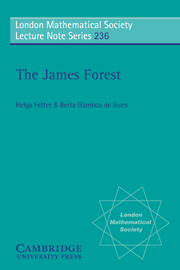Chapter 2 - The James space J
Published online by Cambridge University Press: 19 March 2010
Summary
Nous approchons
Dans les forêts
Prenez la rue du matin
Montez les marches de la brume
Paul EluardIn the appendix of his pioneering treatise [1], S. Banach stated a number of questions about the properties of Banach spaces, some of which remained unanswered for decades, providing a strong stimulus for research. Among them, those regarding the reflexivity of spaces with “enough good properties” were of special importance. In his basic paper [1] in 1950, James introduced the famous space which now bears his name and is called the J space for short; this space was constructed as a counterexample to a question posed by James himself, regarding the reflexivity of spaces not containing subspaces isomorphic to c0 or l1 but proved to be also a counterexample to several of the questions posed by Banach. It soon became a rich source of conjectures, examples and counterexamples which brought about an enormous amount of research around its strange “pathological” behavior.
In this chapter we study the basic properties of J in considerable detail, starting with its fundamental property of quasi-reflexivity and going as far as a description of its isometries. We also treat the dual space J* which in many ways resembles J and yet is completely different; in fact, as we shall see in Section 2.i, J and J* are incomparable, that is, they have no isomorphic infinite dimensional non-reflexive sub-spaces.
The results and their proofs presented here are extracted from numerous sources, but whenever possible and convenient, it is the original proof that is discussed.
- Type
- Chapter
- Information
- The James Forest , pp. 11 - 133Publisher: Cambridge University PressPrint publication year: 1997



